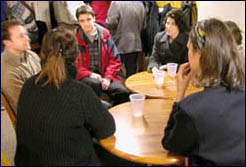
| In addition to meetings and informal exchanges, twenty-five courses are held annually here. In 1945, physicist Max Delbrück started teaching a course on bacteriophages —viruses that infect bacteria. This grew into the courses today. | |

"I think this place deliberately tries to attract and employ and enable scientists with a vision. And that means that they’re looking toward the future, and they have some idea of what the future might bring, right or wrong. So there's no question that at Cold Spring Harbor there's a premium put on attracting that kind of person. Because they are not at a university, they have a little bit more leeway to create an environment that allows that kind of leading-edge creative discovery process to continue.
"Part of that
is to have the infrastructure, culture, and facilities to allow
it to happen. Part of it is this much more risky and intuitive process
of finding those people out there who are driven by these interest
levels. Not careerist goals but really fundamental interest in a
problem."
|
|
|
|
|
|
|
|
|
|
|
|
|
|
|
 "The
bar is a really essential aspect of Cold Spring Harbor. It’s
a place where people meet, they have a beer, they just relax, and
they have a chance to talk about whatever they want to talk about.
This is where you bump into people that do something different.
Over a beer and a casual conversation, you talk about science. And
that’s where you find out that you have so much in common—and
that there are, indeed, things that you can learn from somebody
that does something completely different. It’s really important
to be able to have a regular life, have a beer, and just casually
talk about what the problem is you’re studying."
"The
bar is a really essential aspect of Cold Spring Harbor. It’s
a place where people meet, they have a beer, they just relax, and
they have a chance to talk about whatever they want to talk about.
This is where you bump into people that do something different.
Over a beer and a casual conversation, you talk about science. And
that’s where you find out that you have so much in common—and
that there are, indeed, things that you can learn from somebody
that does something completely different. It’s really important
to be able to have a regular life, have a beer, and just casually
talk about what the problem is you’re studying."